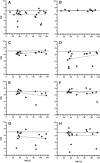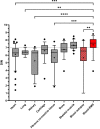Blood taken immediately after fatal resuscitation attempts yields higher quality DNA for genetic studies as compared to autopsy samples
- PMID: 36773088
- PMCID: PMC10421769
- DOI: 10.1007/s00414-023-02966-7
Blood taken immediately after fatal resuscitation attempts yields higher quality DNA for genetic studies as compared to autopsy samples
Abstract
Background: The out-of-hospital cardiac arrest (OHCA) in the young may be associated with a genetic predisposition which is relevant even for genetic counseling of relatives. The identification of genetic variants depends on the availability of intact genomic DNA. DNA from autopsy may be not available due to low autopsy frequencies or not suitable for high-throughput DNA sequencing (NGS). The emergency medical service (EMS) plays an important role to save biomaterial for subsequent molecular autopsy. It is not known whether the DNA integrity of samples collected by the EMS is better suited for NGS than autopsy specimens.
Material and methods: DNA integrity was analyzed by standardized protocols. Fourteen blood samples collected by the EMS and biomaterials from autopsy were compared. We collected 172 autopsy samples from different tissues and blood with postmortem intervals of 14-168 h. For comparison, DNA integrity derived from blood stored under experimental conditions was checked against autopsy blood after different time intervals.
Results: DNA integrity and extraction yield were higher in EMS blood compared to any autopsy tissue. DNA stability in autopsy specimens was highly variable and had unpredictable quality. In contrast, collecting blood samples by the EMS is feasible and delivered comparably the highest DNA integrity.
Conclusions: Isolation yield and DNA integrity from blood samples collected by the EMS is superior in comparison to autopsy specimens. DNA from blood samples collected by the EMS on scene is stable at room temperature or even for days at 4 °C. We conclude that the EMS personnel should always save a blood sample of young fatal OHCA cases died on scene to enable subsequent genetic analysis.
Keywords: Cardiomyopathy; Channelopathy; DNA stability; Emergency medical service; Molecular autopsy; Next-generation sequencing; Resuscitation.
© 2023. The Author(s).
Conflict of interest statement
The authors declare no competing interests.
Figures






References
MeSH terms
LinkOut - more resources
Full Text Sources
Medical

